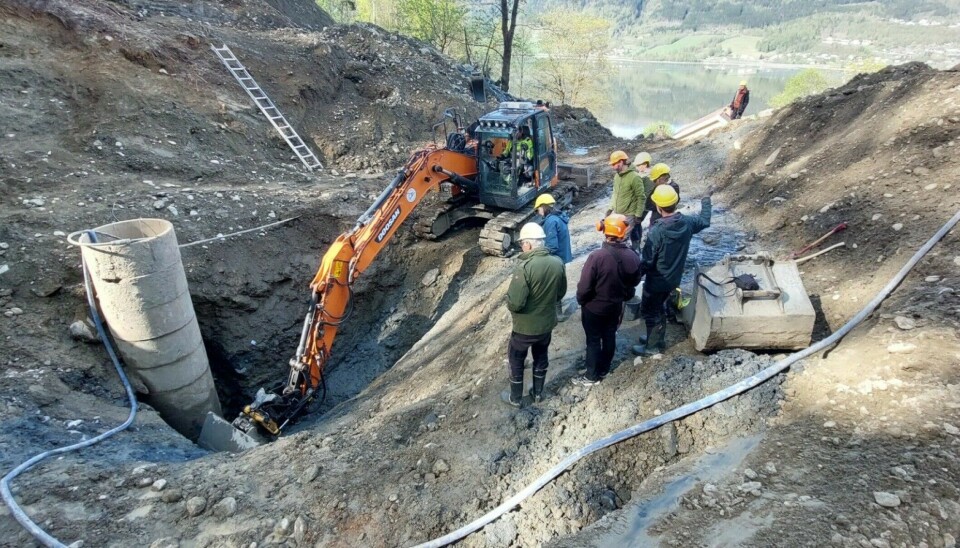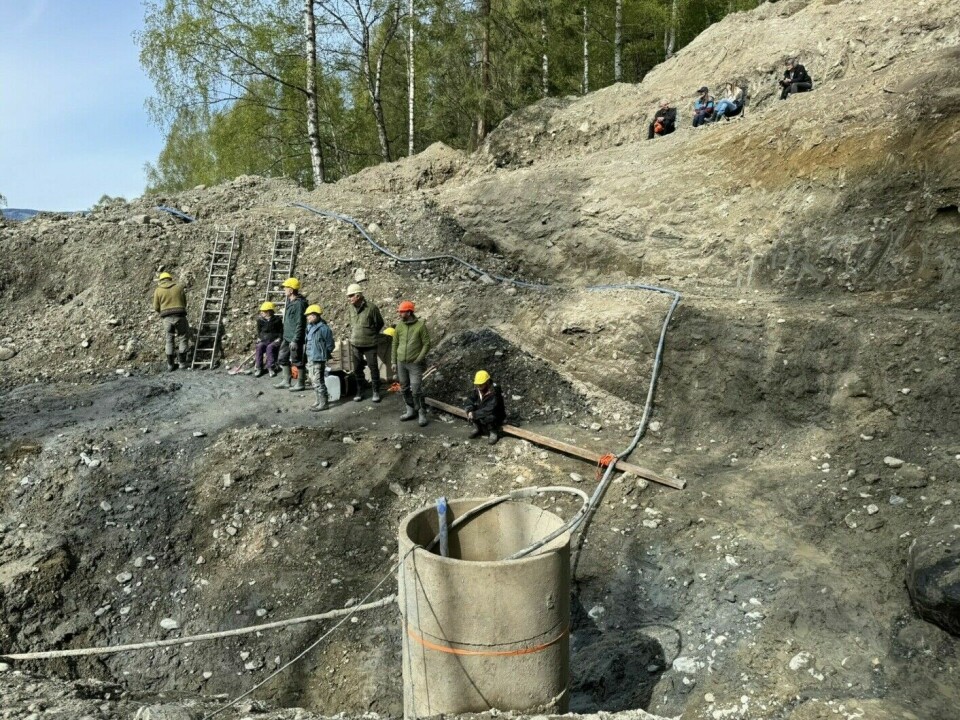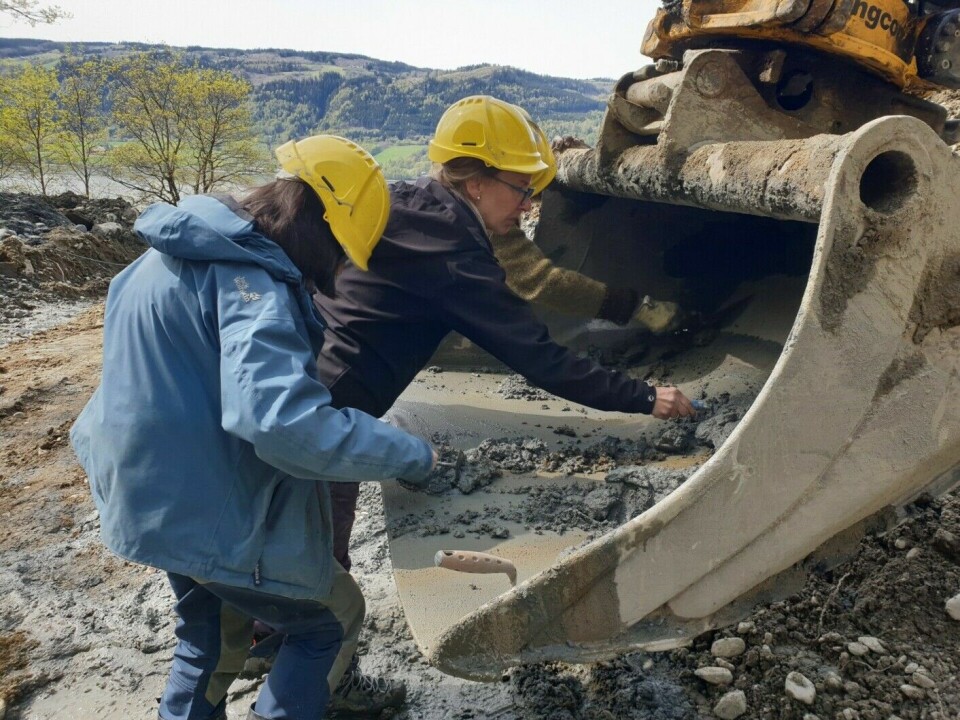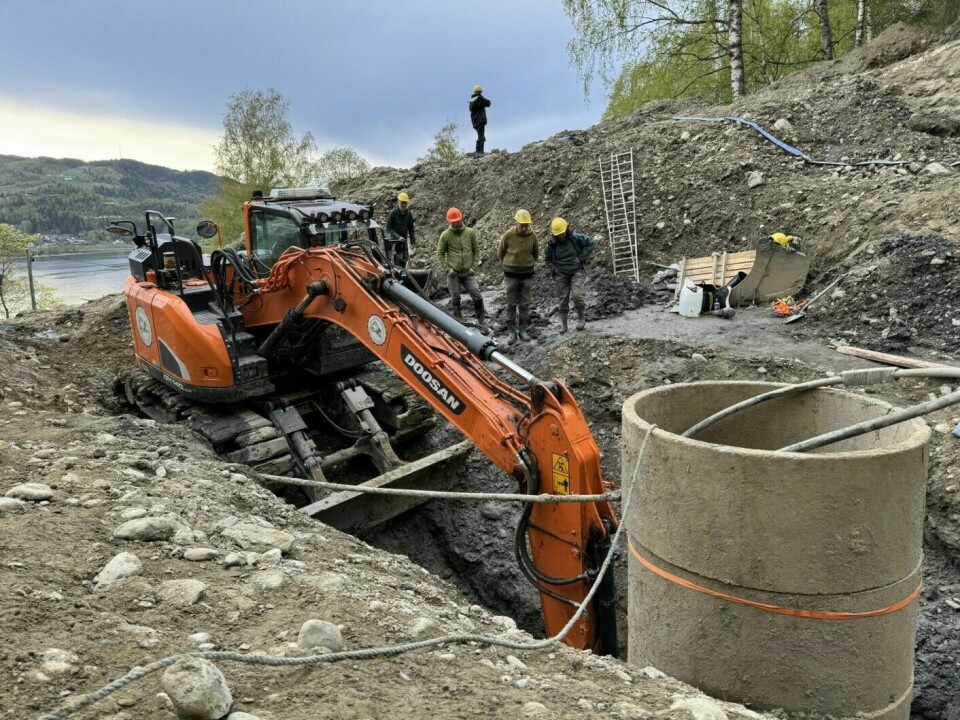
Researchers searched for mammoth remains in Lillehammer. Here’s how it went
No mammoth bones were found, but there is still a lot of soil to sift through. The site could nevertheless become a doorway to the Ice Age, says one researcher.
Researchers in Lillehammer have been searching for mammoth bone fragments in an excavation they began on May 6th.
In 1955, Severin Blessum found two bone fragments identified as coming from a mammoth's shoulder blade.
The farmer had dug a well by hand. The pieces of bone protruded from the soil wall and were knocked loose.
Researchers dug to the bottom of the well to find the site again, look for more bones, and collect sample material.
The excavation itself has now been completed, and the hole has been filled.
Unfortunately, no more mammoth remains were found. But the three tonnes of soil that were excavated remain to be examined.
The researchers did find some plant remains that might be from the Ice Age. They will also search for DNA from Ice Age animals and plants in samples taken along the way. This will be the next phase of the project.
Went as planned
“The excavation went according to plan, and we were able to reach the bottom and take all the samples we had planned,” says Finn Audun Grøndahl, project manager and conservator at the Randsfjord Museum.
“There were some challenges with water. We had to remove water constantly, but it went fine. The weather was on our side.”
Blessum, the farmer, described the bone fragments as being found in blue clay. The researchers reached this layer after six metres. It extended down to just under eight metres.
“It was a very clay-rich deposit, where we took samples at 10-centimetre intervals throughout the layer,” says Grøndahl.

May have been broken down
The researchers focused on the northern side of the well, which is where the find was made in 1955. They also excavated 180 degrees to the east and west.
The masses on the northern side were thoroughly examined on site. The three tonnes of soil that were located to the east and to the west of the well were removed and stored. The soil will be carefully examined for plant and bone remains.
Why wasn't more of the skeleton found?
Grøndahl finds it hard to believe that they could have overlooked something.
“It's possible that the rest may have decomposed after the well was made, due to the introduction of air," he says.
The hole dug 70 years ago was slightly wider than the well itself. The space was filled with stones. Air might have gotten into the soil wall, triggering decomposition.
“We thought there was a very slim possibility that there would be larger parts of the skeleton there. The original mammoth carcass most likely fell apart gradually and was then moved by both other animals and running water,” he says.
“Part of the animal avoided complete decay by being submerged in a clay-rich mass.”
Plant remains
The researchers found a few plant remains during the excavation that might be from the Ice Age. They were particularly interested in remains inside compact clay, hard clay clumps.
“There are lumps of clay that haven't come apart. There is a greater chance that no other material has entered later from landslides or in connection with the well digging,” Grøndahl says.
“We found something we think is moss. Then there were needles either from larch or juniper. We found some root material, but we're more uncertain about that, because it was from outside of the compacted clay.”
These could be remnants of Ice Age plants in the area. But this needs to be confirmed, and Grøndahl is currently unsure if it will be possible to date the remains.

The mammoth steppe
The project will eventually analyse samples for ancient DNA. Researchers will also look for pollen and diatoms. These will be dated.
The project, funded by Innlandet Regional Research Fund, is scheduled to be completed in the spring of 2025.
During the last ice age, the mammoth steppe stretched over large areas in the north.
“This project will help us find out if the mammoth steppe extended to southeastern Norway. We want to see if we can find traces of several characteristic species of both plants and animals,” says Grøndahl.
Most traces of the last ice age have been worn away by the enormous ice sheet that covered Norway when the cold was at its peak.
“We've opened a door to the Ice Age. Whether we found anything in that room remains to be seen, but we succeeded in opening the door,” he says.
Suitable for preserving DNA
Inger Greve Alsos is a professor at the Arctic University Museum of Norway. She is an expert on ancient DNA and participated in the excavation. She will lead the work on searching for DNA in the samples.
She notes that mammoth DNA has previously been found in many places in the Arctic in layers deep in the ground. Mainly in Siberia, Yukon, and Alaska.
“DNA binds especially well to clay, but also to other particles,” Alsos writes in an email to sciencenorway.no.
The soil layers at the excavation site in Lillehammer contain a fair amount of clay.
“That’s why we believe they are suitable for preserving DNA. We already know that there was a mammoth at the site, but we are also interested in finding out what plants were there at the time and any other animals. We hope to determine this with the help of DNA,” she writes.
She adds that Aage Paus at the University of Bergen will be looking for pollen from plants.

Formed by glaciers
Mona Henriksen at the Norwegian University of Life Sciences (NMBU) is an expert on Ice Age geology. Her focus has been the layers that were uncovered as the researchers dug down.
The layer in which mammoth bones were found in the 1950s has been described as blue clay or moraine. The researchers have now seen it with their own eyes.
“It's about a two-metre thick layer of blue clay-rich moraine,” Henriksen says. “Such moraine covers are typically deposited under an active moving glacier.”
The colour comes from the fine matter in the moraine.
“The layer was deposited directly from an active glacier that moved over the ground,” she says.
Ice has a great ability to transport material, Henriksen explains. Ice can erode mountains, but it can also erode and carry away older sediments.
“One possibility is that the glacier picked up a lot of clay-rich sediments, perhaps from a lake further upstream, and that this was mixed together into a moraine mass,” she says.
Henriksen also noted small pockets of sorted sand and gravel in the layer. This may be evidence of meltwater tunnels under the glacier.

Fingers crossed
Henriksen had hoped to find traces of an ancient surface in the layers. Such a surface layer has previously been found in Lillehammer from the last ice age.
Such a layer indicates that the ground was ice-free for a long time, and soil began to form.
“Unfortunately, we didn't find that,” Henriksen says.
Above the bluish moraine, there was a looser, more gravelly moraine layer. At the bottom was a sandy layer. This may have been a deposit from a glacial river.
“We can see that there are least two moraine layers. These have been described previously in the Lillehammer area, and were deposited in different periods. This confirms previous work and findings,” she says.
Henriksen admits that it was a little disappointing that they did not find bones. But she is keeping her fingers crossed that DNA or pollen might be found in the samples.
“This is the only mammoth find that has been made in more clay-rich masses. Clay is better for preserving DNA and pollen than the more sandy gravel material in which most mammoth teeth and bones have been found in Norway,” she says.
———
Translated by Nancy Bazilchuk
Read the Norwegian version of this article on forskning.no






































